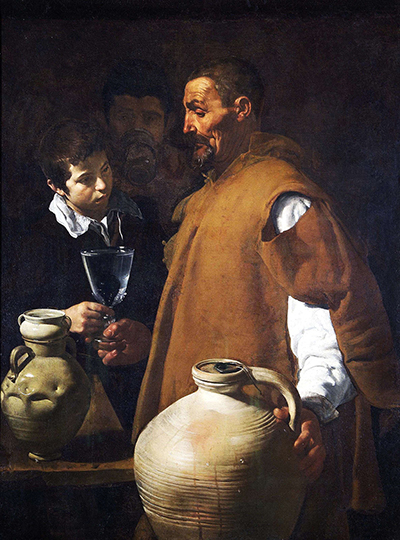The Water Seller of Seville
The Water Seller of Seville offers us an interesting insight into the lives of everyday folk during the Spanish 17th century. We find here a blend of portraiture and still life art within a carefully composed piece from 1618–1622.

The man nearest us has two jugs on his person as he attempts to sell some good quality water to those in the room with him. He looks visibly aged, as if his life is displayed on his face and this sort of look is popular with artists. His strong cheek bones deflect light in different ways, whilst his clothing suggests that he is hard working but far from wealthy. The young man besides him appears to be tasting some of the water in the large glass in his hand. He sports a white shirt under a dark blue top which suggests perhaps a slightly wealthier background than the water seller. In the background is mainly darkness, but for the outline of a number of other figures who are looking on in interest. One of the pleasing aspects of this piece are the still life qualities, with Velazquez somehow able to bring to life the textures and surfaces of these two jugs which are most likely made from clay.
The artwork is dated at 1618-1622, and this wide range is typical of the earlier works from this artist, where little was known about him and no real documentation has survived to allow us to better estimate the timing of these works. Later on, when depicting the royal family, things would be far easier to assess, as records around payment and people's movements allowed art historians to put together a much clearer picture on the events around those paintings. At the time of this painting, Velazquez would only have been in around his late teens and was very much in the process of developing his skills at this time, as well as trying to build a market for his already impressive work. We do know that there were actually several other versions of this painting, suggesting that he was experimenting at the time and learning as he went.
This version of three can be found in Apsley House, London, with further versions found at the Uffizi, Florence plus another which we cannot locate. The version in Italy features less dramatic lighting and the figure at the back is much clearer. It is possible that the one featured in this page came slightly later, as the piece feels more complete overall and is something of a compromise between the other two. Apsley House hosts their Waterloo Gallery and it is there that you will find the Velazquez artwork, alongside some other significant pieces such as Antonio Canova's Napoleon as Mars the Peacemaker as well as a Portrait of Arthur Wellesley, Duke of Wellington by Thomas Lawrence.